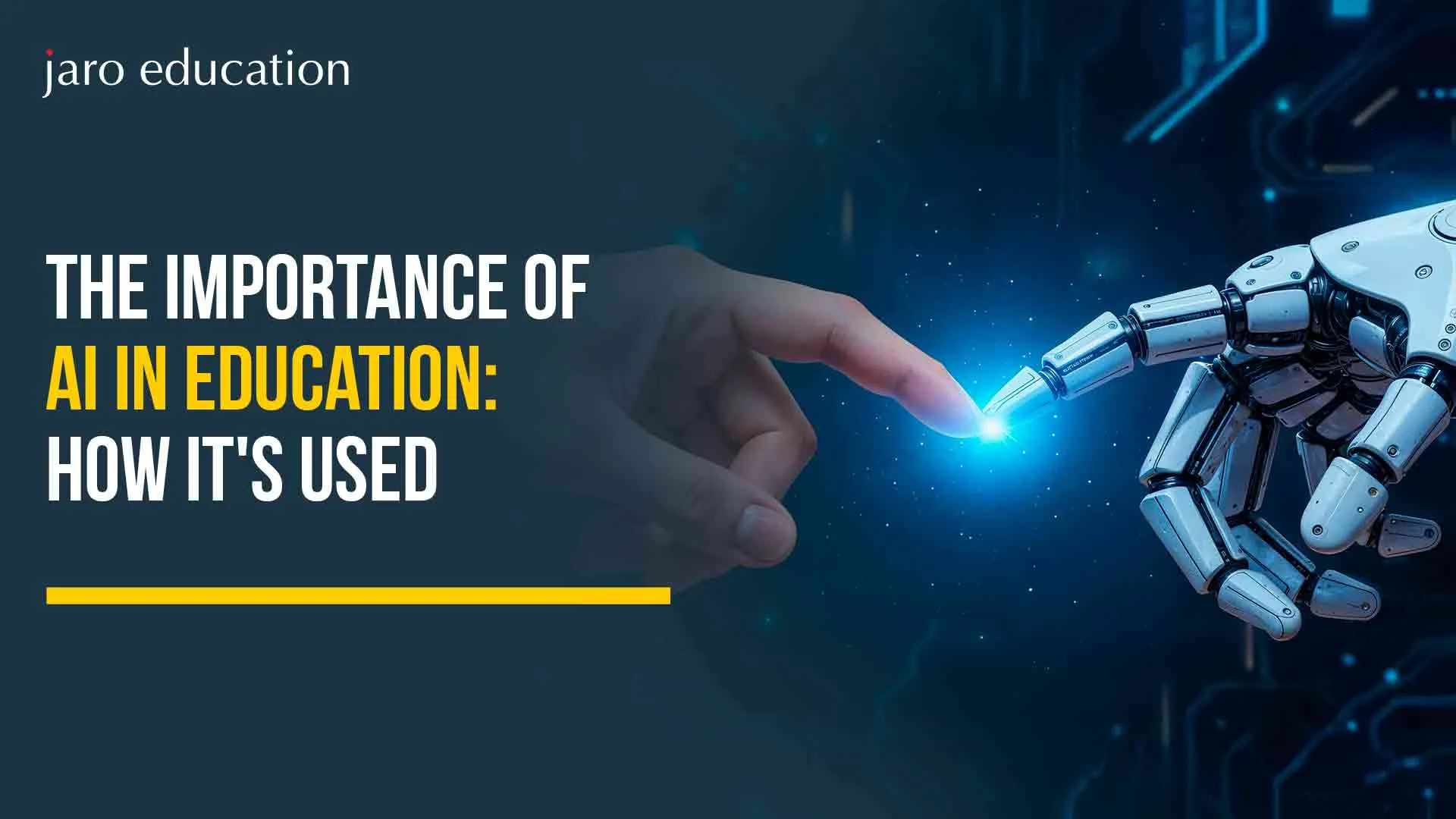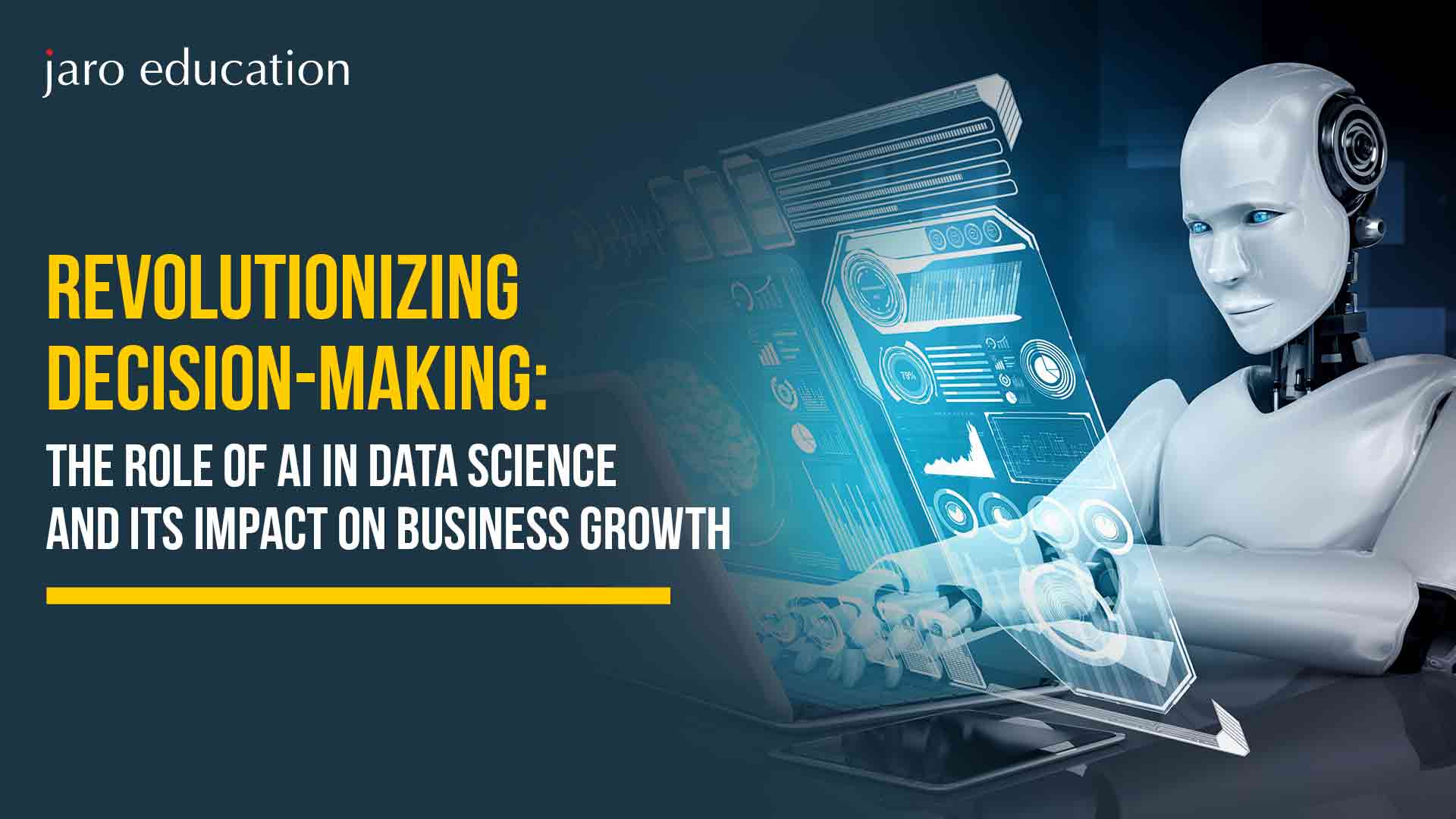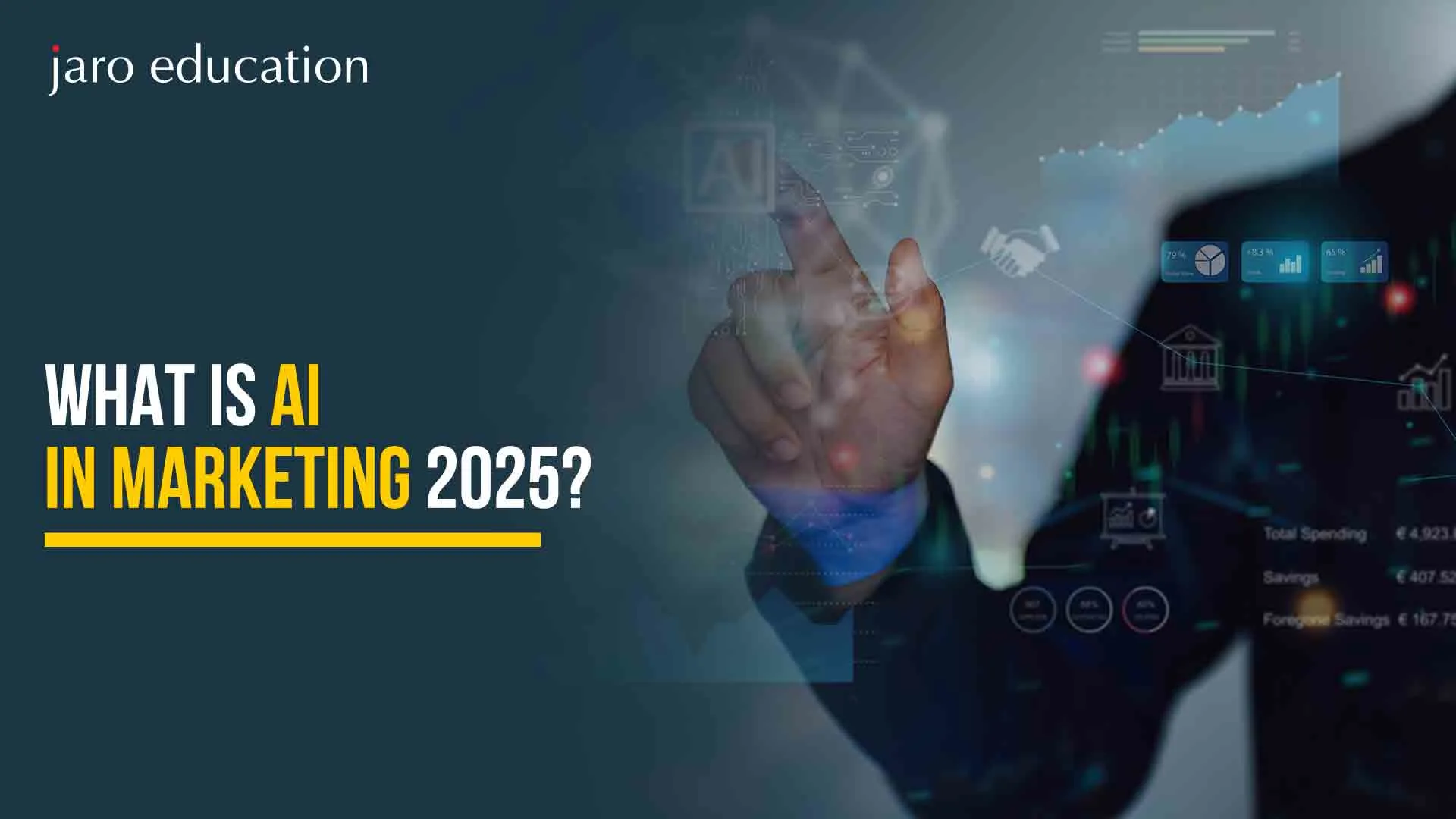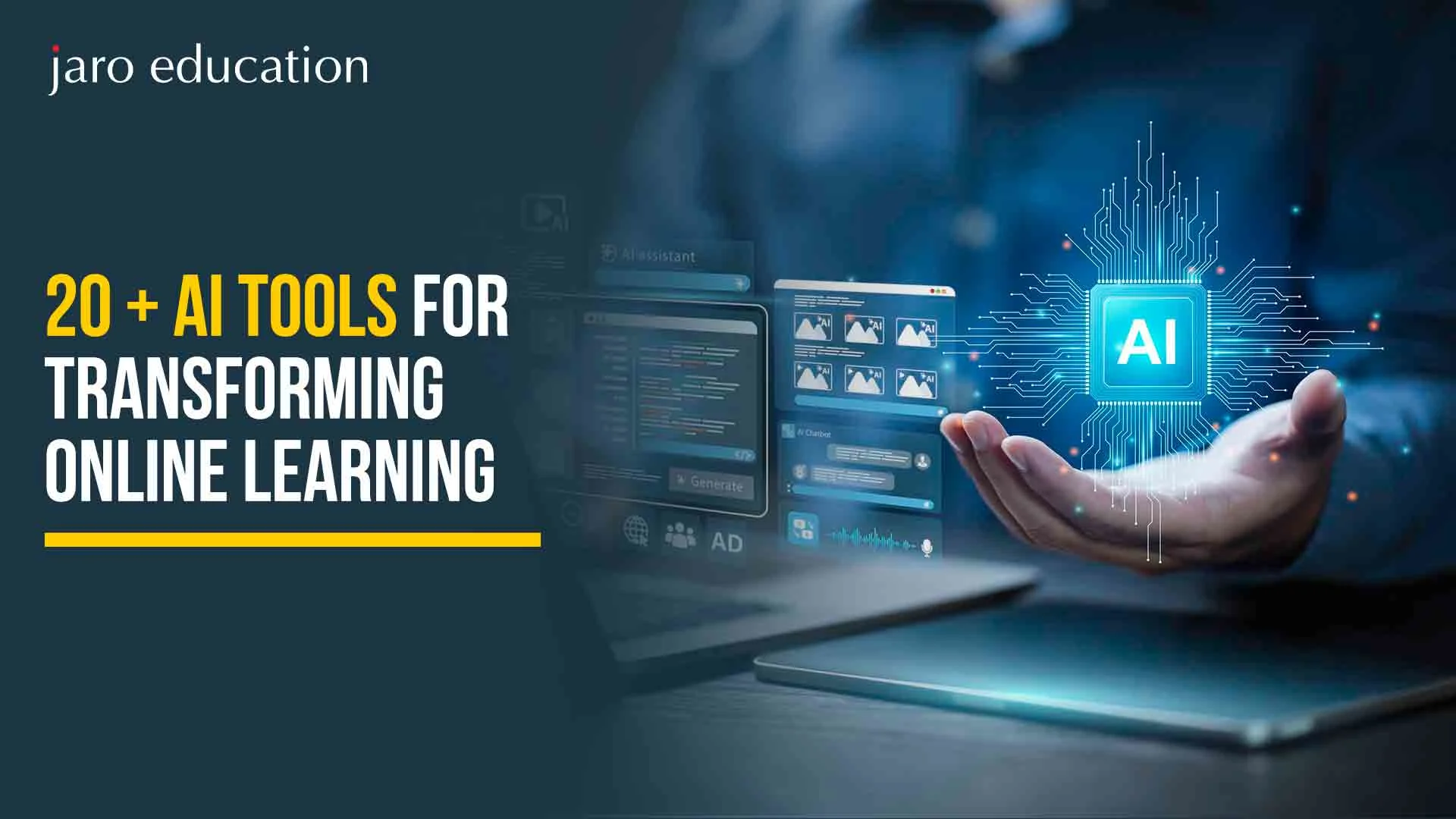AI in Education: Benefits, Use Cases, Cost & More
Table of Contents
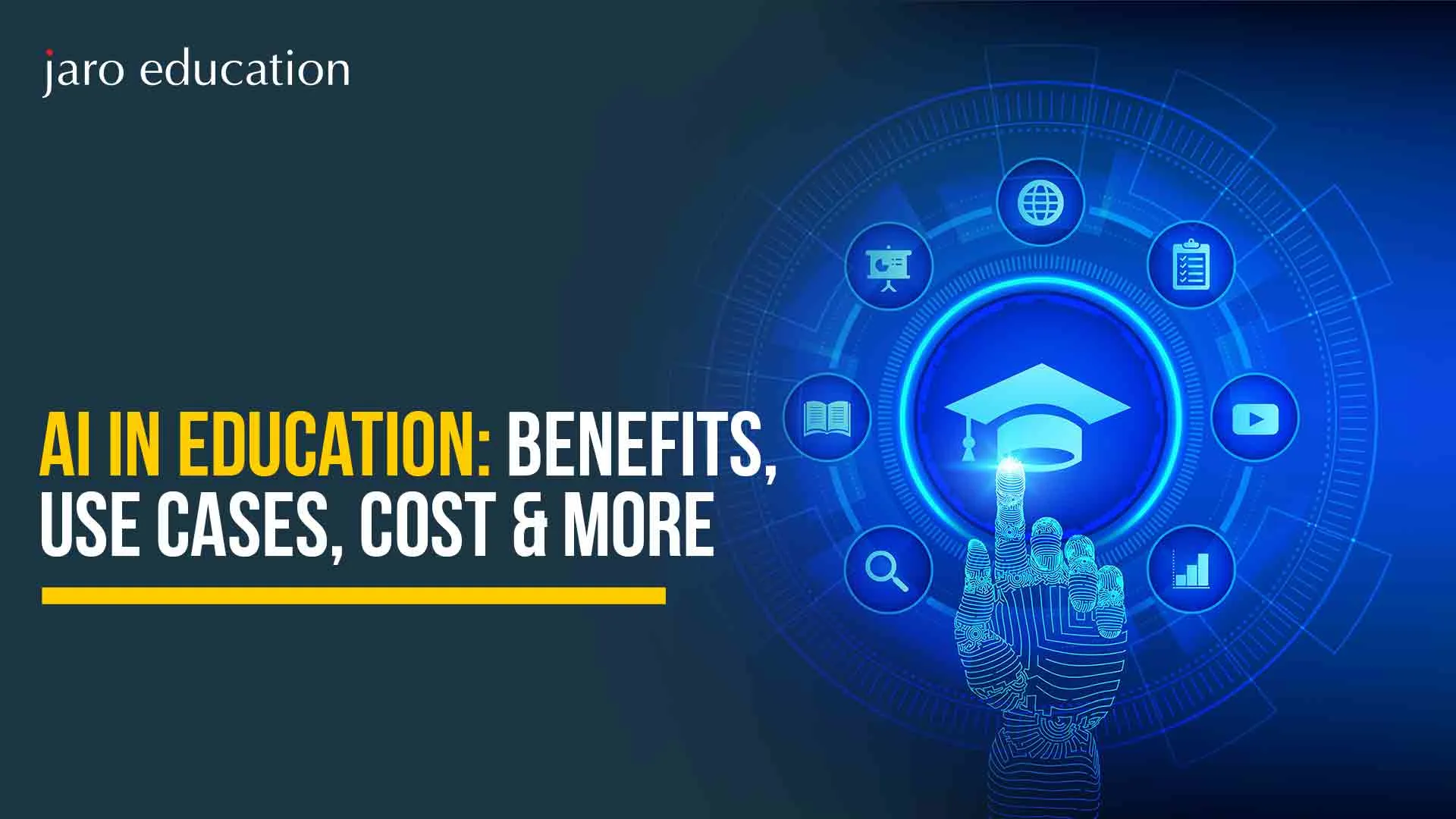
The transformative power of artificial intelligence is no longer limited to tech startups or industrial automation—it is actively reshaping how we learn, teach, assess, and personalise education. AI in education has moved from a buzzword to a practical tool being implemented globally in classrooms, universities, edtech platforms, and even governmental policy frameworks.
With the support of elite institutions like IIT Roorkee, which offers the IIT Roorkee Post Graduate Certificate Programme in Applied Data Science & AI, professionals are being equipped to understand and apply AI technologies in high-impact domains like education.
In this comprehensive guide, we delve deep into the importance of AI in education, real-world use cases, implementation costs, and the future of AI in education sector adoption across different geographies.
Evolution of AI in Education
From basic adaptive learning systems in the 2010s to today’s powerful generative AI tools, AI in education has evolved dramatically. Initially, it began with algorithms that recommended questions based on user performance, but today it includes:
- Automated essay grading
- Intelligent tutoring systems
- Predictive analytics for dropout risks
- ChatGPT-based doubt solvers
- Virtual teaching assistants
- Content generation and curriculum planning tools
This evolution is not a mere technological upgrade—it is a paradigm shift that places learner-centricity, data-driven decisions, and scalable personalisation at the heart of education.
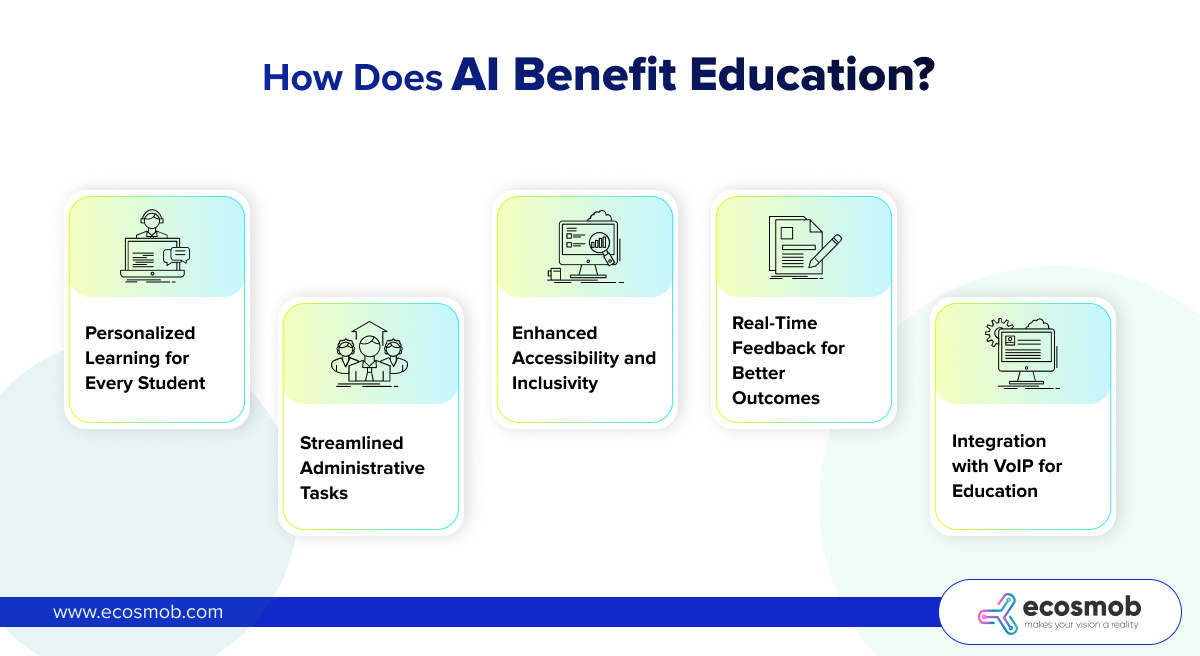
*delivery.rocketcdn.me
Understanding the Importance of AI in Education
The importance of AI in education lies in its ability to remove systemic inefficiencies, democratise access to quality learning, and create hyper-personalised experiences at scale.
Personalised Learning
AI algorithms analyse learners’ performance, pace, preferences, and struggles in real time, enabling educators to customise content for each student. This is especially useful for neurodivergent learners or students with learning disabilities.
Predictive Intervention
Educational institutions use AI-powered analytics to identify students at risk of dropping out or underperforming, allowing for timely academic intervention and counselling.
Administrative Efficiency
From scheduling and admissions to grading and compliance, AI automates a multitude of backend processes, freeing up educators to focus on teaching rather than paperwork.
Global Reach
AI in the education sector can help translate content into local languages, generate subtitles for lectures, and support multilingual voice recognition, making education accessible across geographies.
Advantages of AI in Education
To evaluate the actual business and academic value, let’s take a deeper look at the advantages of AI in education for various stakeholders:
For Students
- Real-Time Feedback: Immediate guidance on assignments, coding errors, and logical reasoning.
- 24/7 Availability: Unlike human tutors, AI doesn’t sleep. Doubts can be solved anytime.
- Gamified Learning: AI powers intelligent games that boost concept retention through interactivity.
- Inclusive Learning: Students with dyslexia, ADHD, or vision impairments benefit from customised AI tools.
For Teachers
- AI Lesson Planning: Tools like ScribeSense and Gradescope help reduce lesson prep time.
- Automated Grading: Saves 30–50% of time by assessing MCQs, essays, and subjective answers.
- Virtual Teaching Assistants: AI bots handle routine student questions, freeing up faculty for advanced mentorship.
For Institutions
- Data-Driven Decisions: Track which courses work, where students drop off, and how to improve.
- Scalable Operations: AI allows institutions to scale teaching without proportionally increasing faculty costs.
- Enhanced Compliance: AI ensures proper documentation for audits, accreditation, and funding.
These advantages of AI in education point toward a more efficient, inclusive, and future-proof academic ecosystem.

*acropolium.com
Application of AI in Education: Real-World Use Cases
A theoretical understanding is incomplete without practical examples. Let’s explore some actual applications of AI in education across different countries and platforms.
Smart Content Creation
Platforms like Knewton and Content Technologies use AI to create personalised textbooks and quizzes based on student behaviour, improving engagement.
Intelligent Tutoring Systems
Carnegie Learning in the U.S. and BYJU’S in India use adaptive learning paths that adjust to a student’s performance in real time. These are textbook examples of AI in the education sector transformation.
Language Translation and Support
Microsoft’s Azure AI and Google’s Translation API help learners from remote areas study global curricula in their native tongues, overcoming linguistic barriers.
Automated Essay Scoring
ETS (Educational Testing Service) uses AI models to grade GRE and TOEFL writing sections, reducing human error and increasing scoring speed.
Virtual AI Mentors
MIT and Stanford deploy AI bots that help students with assignments, answer frequently asked questions, and suggest learning resources, enhancing learning continuity.
Admissions and Enrolment
Institutions use machine learning models to predict student success and automate selection during the admission process.
The application of AI in education is not theoretical anymore—it’s widespread and maturing every year.
Cost of Implementing AI in Education
One of the main hesitations in adopting AI in education is the perceived cost. While it is true that AI in education sector deployment requires investment, the long-term ROI makes it highly viable.
Cost Breakdown (in INR)
Software Licensing
AI-based Learning Management Systems (LMS) can range from ₹16.7 lakhs to ₹1.25 crores annually, depending on the scale of deployment and features.
Cloud Infrastructure
AI requires scalable storage and high computational power. Expect an annual cost between ₹2.5 lakhs and ₹41.75 lakhs, depending on user load and usage.
Customisation & Integration
Tailoring the application of AI in education to align with local curriculum and existing systems can initially cost ₹8.35 lakhs to ₹58.45 lakhs.
Training & Adoption
Faculty training through workshops and certification sessions may cost ₹83,500 to ₹4.2 lakhs per session, depending on the institution’s needs and partner vendors.
Maintenance & Updates
AI tools require frequent updates and performance tuning. Annual maintenance may cost 10–15% of the total deployment cost, potentially ranging in several lakhs annually.
Despite the initial expenses, the automation of grading, admissions, and administrative support leads to substantial long-term savings. Additionally, many institutions leverage open-source platforms or partner with edtech companies to reduce expenses and operational complexity.
AI in Education Sector: Global Trends & Adoption
The AI in education sector is expected to be valued at approximately ₹1.67 lakh crores by 2027, according to HolonIQ. Let’s look at how different countries are approaching AI implementation in academia.
United States
- Government-funded programmes in K-12 using AI for early literacy.
- Stanford’s AI + Education initiative studies optimal learning models.
India
- NEP 2020 encourages the integration of AI in curricula.
- CBSE has launched AI modules in partnership with Intel.
- Institutes like IIT Roorkee are driving academic programmes like the Post Graduate Certificate Programme in Applied Data Science & AI to prepare professionals for such high-demand roles.
Europe
- The EU’s Digital Education Plan emphasises AI ethics, governance, and responsible use.
- Finland offers free AI education to citizens under its “Elements of AI” initiative.
Middle East
- UAE’s Mohammed Bin Zayed University for AI (MBZUAI) is entirely dedicated to AI research and deployment.
- Ministries are piloting AI in Arabic language instruction using NLP tools.
The global AI in education sector is not uniform in growth, but the momentum is undeniably upward.
Ethical Considerations in AI in Education
While the benefits of AI in education are substantial, ethical questions loom large over its implementation. As we advance toward smarter, data-driven learning, we must also tread carefully to ensure equity, transparency, and fairness.
Data Privacy & Consent
Student data is the backbone of AI algorithms. But who owns this data? Are parents and students informed about how their information is used?
The importance of AI in education should never override the ethical imperative to protect personal data. Institutions must comply with laws like GDPR, COPPA, and India’s upcoming DPDP Act when deploying AI tools in learning environments.
Bias in Algorithms
AI systems are only as unbiased as the data they’re trained on. For example, if a dataset used for grading contains historical biases, AI could end up perpetuating unfair evaluation metrics.
Overdependence on Automation
AI shouldn’t replace human teachers—it should enhance them. Emotional intelligence, empathy, and contextual understanding are still uniquely human traits. A balance must be maintained between automation and human connection.
Accessibility Gaps
The cost of infrastructure, internet access, and device availability can create a divide, making AI in the education sector accessible only to privileged groups. Ensuring inclusivity is a moral necessity.
Future Classroom with AI Integration
What does a future-ready classroom powered by AI in education look like? It’s immersive, inclusive, and hyper-personalised. Here’s a futuristic projection:
AI-Powered Lesson Plans
Teachers will receive dynamic, real-time lesson suggestions based on student mood, attention levels, and academic progress. These plans adapt every day.
Virtual Reality + AI
Imagine a 10th-grade student learning the structure of DNA by walking inside it through VR goggles, guided by an AI mentor who explains in real time based on the student’s prior knowledge.
Emotion-Sensing AI
AI tools will track facial expressions and engagement levels to detect boredom, confusion, or interest, offering real-time cues to teachers.
Learning Analytics Dashboards
Parents, teachers, and even students will have dashboards showing personalised learning paths, predicted outcomes, and suggested interventions.
AI-Based Peer Collaboration
AI will recommend study partners based on learning styles, performance, and even temperament, optimising group learning outcomes.
Clearly, the advantages of AI in education will become more tangible as we move forward, making learning an adaptive and responsive journey.
Challenges in Implementing AI in Education
Despite its potential, the path to integrating AI in education is fraught with barriers:
Lack of Skilled Workforce
Educators often lack training in AI systems, making implementation difficult. That’s where programmes like the IIT Roorkee Post Graduate Certificate Programme in Applied Data Science & AI play a crucial role in bridging the skills gap.
High Initial Investment
The upfront cost of AI infrastructure is still a challenge for budget-constrained institutions. Governments and edtech partnerships are essential to fund such transitions.
Resistance to Change
Teachers, parents, and even students may resist AI due to unfamiliarity or fear of losing the human touch in learning.
Infrastructure Disparity
In developing countries, rural areas may lack access to high-speed internet or smart devices, creating inequality in access to AI in education tools.
Regulation Lag
AI is evolving faster than policy frameworks. Without adequate regulation, misuse or unintended consequences could arise in classrooms.
Final Thoughts
The promise of AI in education is not just futuristic—it’s already unfolding around us. From smart tutors and grading bots to predictive analytics and immersive learning experiences, AI is making education more efficient, engaging, and equitable.
However, to fully unlock the advantages of AI in education, we must address its challenges head-on, particularly issues around access, ethics, and training. The application of AI in education must be driven not only by innovation but also by inclusion and responsibility.
Professionals looking to make a meaningful impact in this space can greatly benefit from programmes like the IIT Roorkee Post Graduate Certificate Programme in Applied Data Science & AI, which offer the technical depth and contextual relevance needed for today’s AI-driven academic revolution.
As we move ahead, one thing is clear: the importance of AI in education will only continue to grow, making it an indispensable ally in shaping future generations of learners and leaders.
Frequently Asked Questions
Can AI help bridge educational gaps in under-resourced regions?
Yes, AI in education can offer scalable solutions like low-bandwidth adaptive learning apps, multilingual content delivery, and personalised tutoring that are especially useful in rural or underserved communities. These AI-driven tools can democratise access to quality education where trained teachers or physical infrastructure may be limited.
How does AI support inclusive learning for students with disabilities?
AI-powered tools like speech-to-text converters, smart readers, emotion-detection software, and personalised learning systems can help students with visual, auditory, cognitive, or learning disabilities. These applications of AI in education enhance classroom engagement and offer equitable learning experiences.
Are there ethical concerns related to AI in classrooms?
Yes, while the advantages of AI in education are numerous, there are ethical considerations such as data privacy, algorithmic bias, and over-reliance on automation. Schools must adopt AI responsibly with transparent data policies and human oversight.
Can AI assist teachers in real-time classroom management?
Absolutely. AI-powered classroom monitoring systems can analyse student engagement. Track behaviour patterns, and even provide real-time alerts if a student is struggling or disengaged. These tools help educators intervene early and optimise lesson pacing or teaching methods.
How can parents be involved in AI-integrated learning environments?
AI-based platforms can provide detailed performance analytics and behaviour reports to parents, enabling more informed discussions and support at home. Parent-specific dashboards, alerts, and insights can help create a cohesive learning ecosystem between school and home.













